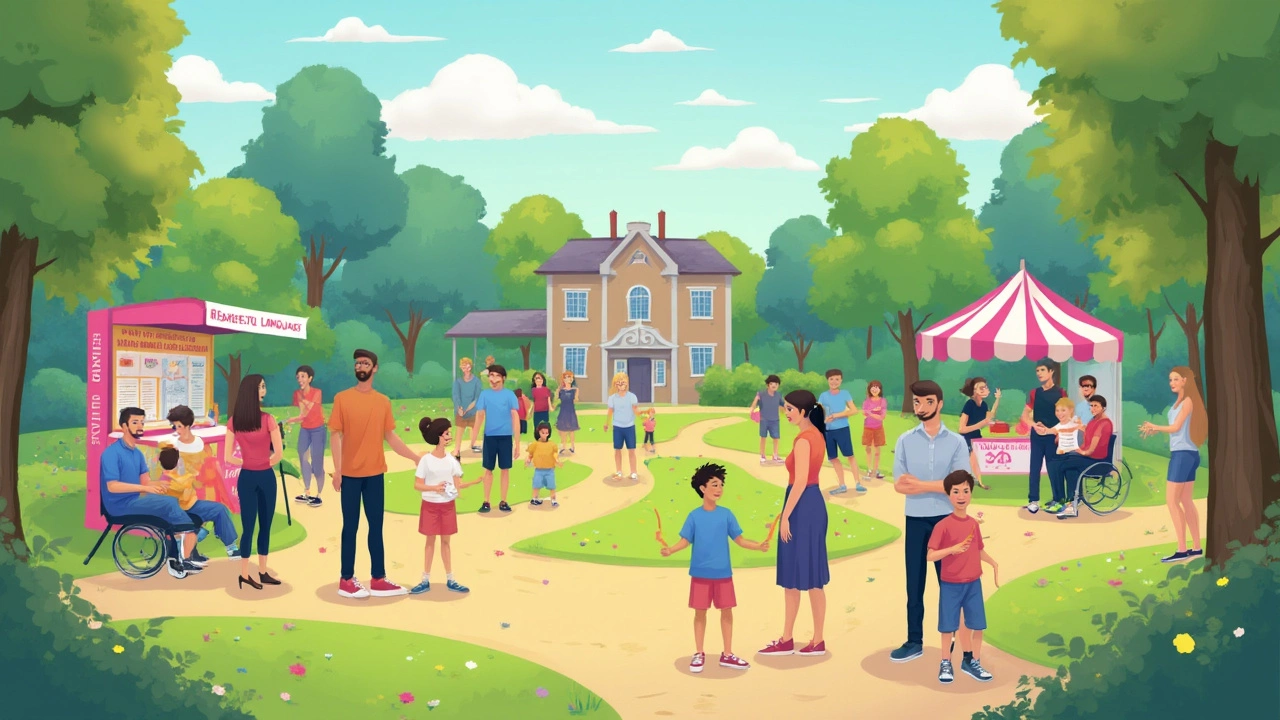What's in a name? Well, when it comes to kids with special needs, a lot! Our choice of words can shape the way we think about and treat children who learn and develop differently. It's like calling a quick team meeting before a big game. Language sets the tone! Historically, we've tossed around terms like 'handicapped' or 'mentally retarded' without batting an eye, but today, those words are ancient relics in the realm of special education.
Nowadays, there's a buzz around using what's called person-first language. Basically, it's about seeing the child before their condition. So instead of saying 'an autistic child,' you'd say 'a child with autism.' It's our little way of emphasizing that these kiddos have identities beyond their needs.
- The Power of Words
- A Brief History of Terminology
- The Shift to Person-First Language
- Why Language Matters in Education
- Terms to Use and Avoid
- Tips for Promoting Inclusion
The Power of Words
Words are more than just sounds strung together; they're powerful tools that can shape how we think and feel. When talking about special needs or inclusive education, the words we use can either build barriers or break them down. It might seem like just semantics, but calling a child 'disabled' versus 'a child with a disability' has a real impact.
The shift towards person-first language is a push towards seeing these kids for who they are—individuals first, their conditions second. This perspective shift is important in helping everyone see the value in diversity. Instead of labeling them as 'different,' we celebrate their uniqueness.
Respect and Dignity
Using the right terms is about offering respect. It acknowledges children's dignity. Imagine being reduced to a label; it's not fun! That's why educators, parents, and society at large are adapting their language—because every child deserves dignity.
Social Influence
Our words influence the way others view and interact with kids with special needs. Teachers in special education environments notice that using positive language fosters a more accepting classroom atmosphere. It's one step towards normalizing differences, and it can influence how kids treat each other on the playground too.
If you're ever unsure about what the right term is, it's okay to ask. It's better to learn and update your vocab than to cling to outdated and potentially harmful language. This not only shows you care about the individual but are committed to fostering inclusivity.
A Brief History of Terminology
We've really come a long way in how we talk about children with special needs. Buckle up, because it's been quite the ride! Back in the day—think early 1900s—terms like 'idiot' and 'imbecile' were actually used in medical settings. Wild, right? These words, originally clinical, quickly turned into insults, showing just how quickly language can evolve.
In the mid-20th century, 'mentally retarded' became the accepted term. It was used in education, medicine, and law. However, by the late '80s and '90s, people began to realize how hurtful and limiting those words could be. Activists and educators started pushing for change, emphasizing the importance of respectful language.
"The words we choose to describe people should celebrate abilities, not disabilities." – An educator from the National Inclusion Project
By the late 1990s, the term 'special needs' was gaining traction. It aimed to cover a range of conditions—emotional, physical, and cognitive. It's not perfect, but way better than the alternatives from the past.
Inclusive education plays a big role in how we talk about these kiddos today. With more kids being integrated into regular classrooms, the language shift reflects a broader societal change. Schools aim for zero separateness, meaning every child learns together. Neat, huh?
The Shift to Person-First Language
There's been a big change in how we talk about children with special needs, thanks to a shift towards what's called person-first language. This approach encourages us to see kids as kids first, not just as their diagnosis. It might seem like just a change in semantics, but it's a game-changer in promoting respect and dignity.
The idea is pretty simple: instead of labeling a child as their condition, like saying 'autistic child,' you say 'child with autism.' This small tweak acknowledges that these characteristics are just part of who they are, not their entire identity. It helps create a more accepting and inclusive environment for all students.
Why the Change?
This shift gained momentum in the 1990s when disability advocates began pushing for language that emphasized the person over the disability. Transport yourself back to a time before social media, and think about how words like 'handicapped' were more commonly used. Fast forward to today, it's transformed the game of special education!
Language's Impact on Perception
Words can influence how society perceives disabilities and those who live with them. Employing person-first language is a direct way to combat stereotypes. It's like putting the spotlight on the individual's capabilities rather than their limitations. In schools, this helps establish an environment where differences are not only accepted but celebrated.
What Parents and Educators Can Do
- Model the use of person-first language when talking about children. It sets an example for others to follow.
- Educate kids about why language matters. This can be part of lessons about empathy and respect.
- Encourage open conversations where children can express how they feel about labels and language.
Data shows that classrooms using inclusive language report higher engagement and self-esteem among students with special needs. By embracing this language shift, we're empowering children to take control of their own narratives and be seen for who they really are—individuals with dreams, talents, and much more beyond their diagnosis.

Why Language Matters in Education
Language isn't just about communication; it's about shaping reality and setting the foundation for inclusive environments. In the world of special education, the words we use can either empower or belittle. That's why it's important to watch our language when discussing kids with special needs.
So, why does it matter so much? For one, language influences how children see themselves and their place in the world. When you use positive, person-first language, you're telling a child, 'Hey, you're more than what's on your IEP (Individualized Education Program).' That's a big confidence booster!
Impact on Inclusion
Using the right words helps create a sense of belonging in the classroom. It encourages understanding and reduces stigma among peers. When educators refer to 'a child who uses a wheelchair' rather than 'a wheelchair-bound child,' it sets a tone of capability instead of limitation. Words matter in inclusive education—they set the stage for how classmates, teachers, and even parents interact with kids.
Changing Perceptions
Believe it or not, words can be game-changers. Research shows that negative language can lead to negative perceptions. When teachers use inclusive language, it helps shift mindsets from focusing on what a child can't do to celebrating what they can do. For example, highlighting a child's interests and strengths alongside their learning needs fosters a more positive learning environment.
Making Language Changes
Changing how we talk about kids might seem minor, but it's a big step toward fostering acceptance. Start small—substitute 'disabled child' with 'child with a disability' and see the difference it makes. Encourage educators, students, and parents to embrace this language shift. After all, it's our collective effort that makes the educational space more welcoming for every child.
| Term | Preferred Usage |
|---|---|
| Handicapped | Person with disabilities |
| Mute | Non-verbal |
Terms to Use and Avoid
When chatting about children with special needs, the words we pick really matter. It’s like choosing the right gear for a hike – you want to make sure everyone feels supported and respected on the journey. Let’s break down which terms are cool to use and which ones we should totally skip.
Terms to Use
Here are some terms that are generally accepted and foster a respectful environment:
- Person-First Language: This means saying 'a child with autism' instead of 'an autistic child'. It highlights the fact that they're a person first, not defined solely by their needs.
- Disability vs. Special Needs: 'Disability' sometimes gets a bad rap, but it's okay to use when talking specifics, like 'a child with a learning disability'. 'Special needs' is more of an umbrella term.
- Neurodivergent: This trendy term celebrates brain differences. Handy when talking about conditions like autism or ADHD.
Terms to Avoid
Some words are relics from the past and can be hurtful, even if we don’t mean them to be:
- Retarded: This term is now seen as derogatory and outdated. Swap it for terms like 'intellectual disability'.
- Handicapped: While once common, 'handicapped' is now considered antiquated. 'Person with a disability' is the better way to go.
- Normal: Beware of calling others 'normal' as it can imply that those with special needs are 'abnormal', which isn't quite right.
Why Does it Matter?
Using the right words is like creating a community where everyone feels they belong. It’s more than just being politically correct; it’s about showing that we respect their identity and individuality. When educators, parents, and even kids learn to navigate this language, it builds bridges and makes it easier for everyone to grow together.
Tips for Promoting Inclusion
Creating an inclusive environment for kids with special needs isn't just a nice idea, it's essential. When kids feel accepted, it can boost their confidence and eagerness to learn. So, how can we make sure we’re doing our part to promote inclusion every day?
Understand and Educate
Knowledge is power, right? Start by learning about the diverse range of abilities and challenges kids with special needs face. Sharing this knowledge with others helps build empathy and understanding. Schools and communities can organize workshops or guest speakers who can provide valuable insights. As the famous special educator David Mitchell once said,
"Real inclusion needs understanding and knowledge shared by all."
Diverse Teaching Methods
Teaching isn't one-size-fits-all, especially in special education. Use a mix of visual, auditory, and hands-on activities to make sure every child can connect with the material. Adaptive tools, like speech-to-text devices or sensory-friendly classrooms, can work wonders for kids who might struggle with traditional learning methods.
Encourage Peer Interaction
Relationships are key! Encourage kids to mix and mingle. Buddy systems or group activities where roles rotate can be great. It helps kids learn to appreciate differences and builds lasting friendships. Plus, let’s be real—kids learn a lot from each other!
Promote Empathy Early
Kids are like sponges, soaking up everything around them. Teach them early about empathy and kindness. Simple conversations about how everyone has unique strengths and challenges can make a big difference. Schools can run programs or activities to promote this understanding.
- Integrate stories and books that feature children with special needs.
- Show how being different can be cool through school projects.
- Celebrate special needs milestones like World Autism Awareness Day.
By taking these simple, actionable steps, we’re on our way to making the world a little more welcoming for everyone. And hey, isn’t that something we all want?

